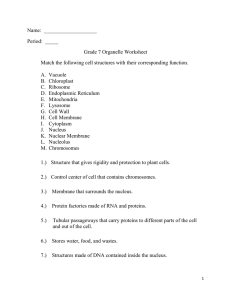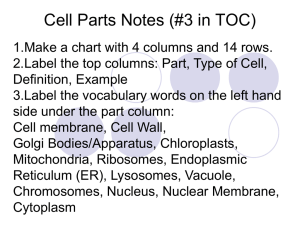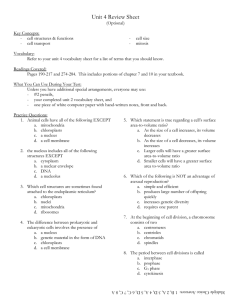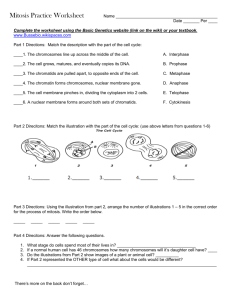Basic Cell Biology
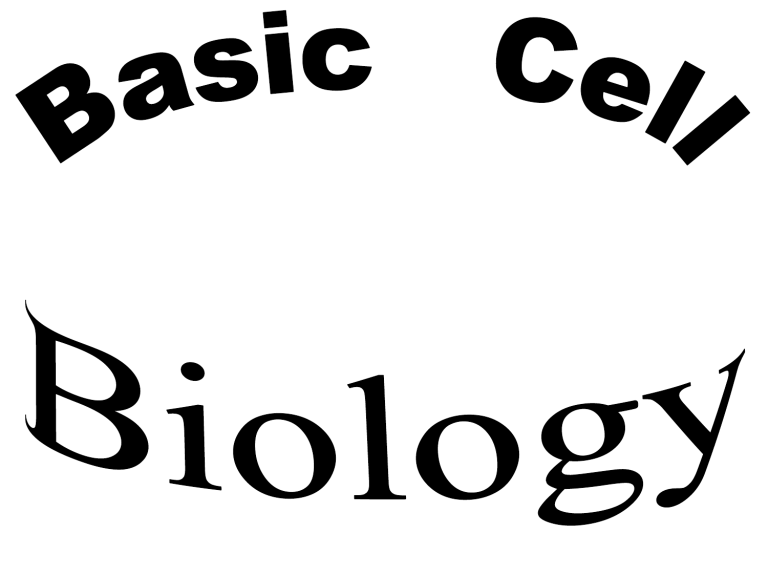
All living things are composed of cells.
Cells are the “building blocks” of living things.
Each type of cell has a particular role to play, and the shape of the cell is related to that role.
Almost all cells contain at least 3 parts: cell membrane, cytoplasm, and a nucleus.
All cells have a cell membrane, also known as the plasma membrane.
It is semipermeable, which means it only allows certain materials to pass through the cell. (Ex: water
& other nutrients needed for life processes)
It also gets rid of waste materials from those processes that would otherwise build up and harm the cell.
Molecules in a solution pass through the membrane from a region of high concentration to a region of lower concentration. This process is called diffusion.
Water passes through the semipermeable cell membrane in a process called osmosis. Water moves from a region of high concentration to a region of low concentration.
Osmosis and diffusion allow the cell to remain constant even though conditions in the environment change. This ability of an organism to remain stable when conditions around it change is called homeostasis.
Cells are filled with a thick, clear fluid that surrounds the nucleus.
This fluid, cytoplasm, contains all the material needed by the cell to conduct life processes.
It aids in moving these materials, is constantly moving, and suspends other parts of the cell.
*It’s what gives the one-celled organisms, like amoeba, its ability to move.*
Serves as “control center” for all cell activities.
Not all cells have a true nucleus:
- Eukaryotic cells: cells with a nucleus (ex: plants, animals)
- Prokaryotic cells: cells that lack a true nucleus (ex: bacteria)
Made primarily of nucleic acids, proteins, and enzymes.
Surrounded by a double layer membrane that regulates movement into and out of the nucleus.
Contains genetic code that gives the organism the characteristics its possesses.
This genetic code is contained in a substance called
DNA (deoxyribonucleic acid).
The molecules of DNA are arranged in threadlike strands called chromosomes.
Segments of chromosomes are called genes and are responsible for transferring genetic codes.
*We will study this further in the reproductive system.*
Small structures within cytoplasm that serve different roles.
Mitochondria:
“powerhouse of the cell”. Breaks down food nutrients and supplies the cell with its energy. Cells that use more E (ex. Muscle cells) contain more mitochondria than cells that are less active (ex. Bone cells).
Vacuoles: serve as the storage compartments for the cell. They consist of a membrane that encloses water and other materials. They store nutrients and enzymes needed by cells. They provide a storage space for waste materials given off by the cell.
Microtubules: Found in animal cells, these organelles are shaped like thin, hollow tubes that are composed of proteins and act as the
“bones” of the cell. These support the cell, give it shape, and assist in the movement of chromosomes during cell division.
Microfilaments: Fine, fiber-like structures composed of proteins that help the cell to move by waving back and forth.
Ribosomes: Protein builders of the cell.
Golgi bodies or Golgi apparatus: Shaped like a group of flat sacs bundled together. They remove water from proteins and prepare them for export from the cell.
Endoplasmic reticulum: large webbing or network of double membranes throughout the cell that transport material within a cell. Smooth endoplasmic reticulum looks like tubes, while rough endoplasmic reticulum has ribosomes attached and looks like sheets of membranes.
Lysosomes: digestive units of the cell. They digest proteins, carbohydrates, and other molecules. Any foreign materials such as bacteria that enter the cell are digested in the lysosomes.
Centriole: set of microtubules found in pairs near the nucleus.
Complete the Basic Cell Biology Worksheet for a grade! Be sure your name is on it and handed in completed sheet (front
& back) when done!
All growth that takes place in living organisms results from cells increasing in size or numbers.
Cells have a very limited size to which they grow, so most growth results from cells reproducing or multiplying.
When injuries occur to either plants or animals, cells reproduce to heal the wound.
When a cell grows, it reaches a maximum size. When this size is reached (parent cell), the cell divides into 2 cells
(daughter cells).
This process is called mitosis . The genetic coding in the nucleus is duplicated and transferred to the new cells.
Period when cell is not actively dividing. It synthesizes materials and moves them in and out of the cell. It is a period of cell growth. When cell is correct size, the chromosomes are duplicated and becomes ready to divide.
First stage of mitosis. Centrioles move to opposite ends of the nucleus and mitotic spindles of thread begin to appear.
Chromatids move toward the center of the spindle (called the equator). When they reach the center, the centromere of the chromatids connect to fibers of the spindle.
Third stage of mitosis. The pairs of chromatids separate into an equal number of chromosomes, and the centromeres duplicate. When separation occurs, the chromosomes move to opposite ends of the cell.
Final stage of mitosis. Remains of the spindle begin to disappear, and new membranes form around the chromosomes. This forms two new nuclei.
- Mitosis v Meiosis Web Quest
- Meiosis Web Quest
- Meiosis Study Guide
***Be sure all research assignments are completed and handed in for credit!***
